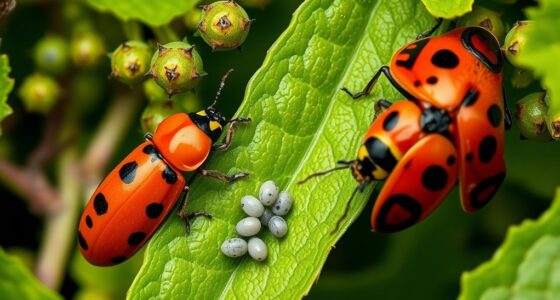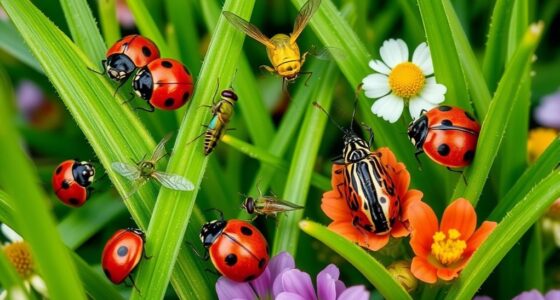To attract lacewings with native plants, choose flowering species like milkweed, coneflower, and goldenrod that provide nectar and pollen. Plant a diverse mix, including early, mid, and late-season blooms, to support them throughout their lifecycle. Incorporate shelter options like native shrubs, tall grasses, or insect hotels, and provide shallow water sources. Avoid pesticides to protect these beneficial insects. If you keep exploring, you’ll discover how to create a thriving habitat that naturally encourages lacewings to flourish.
Key Takeaways
- Plant a diverse selection of native flowering plants blooming throughout the seasons to provide continuous nectar and pollen for lacewings.
- Include native species like milkweed, goldenrod, coneflowers, and asters to attract and support lacewing populations.
- Create habitat features such as brush piles, native shrubs, and insect hotels to offer shelter and breeding sites.
- Avoid pesticides; use organic methods and physical barriers to protect lacewings and encourage their natural pest control.
- Maintain healthy native plantings, manage invasive species, and incorporate shallow water sources to sustain lacewing habitats year-round.
Understanding the Role of Lacewings in Your Garden

Lacewings play a vital role in maintaining a healthy garden ecosystem by naturally controlling pests. Understanding the lacewing lifecycle helps you appreciate their pest control benefits. As larvae, lacewings are voracious predators, feeding on aphids, mites, and other small insects. They consume large quantities of pests, reducing the need for chemical treatments. Adult lacewings, while less aggressive, also contribute by feeding on nectar and pollen, which helps sustain their populations. The complete lifecycle from egg to adult ensures continuous pest management throughout the growing season. By attracting lacewings to your garden, you harness their natural pest control benefits, promoting healthier plants without resorting to pesticides. Their lifecycle makes them valuable allies in maintaining a balanced and thriving garden ecosystem. Additionally, providing native plants can significantly improve the likelihood of attracting and supporting lacewing populations.
Selecting Native Plants That Attract Lacewings

To effectively attract lacewings to your garden, focus on planting native species that provide essential nectar and pollen sources. Native plants support pollinator partnerships and help prevent the risk of invasive species taking over. Choose plants that bloom at different times to guarantee a continuous food supply for lacewings. Avoid invasive species that can outcompete native plants and disrupt local ecosystems. Incorporate a variety of flowering plants to attract lacewings and other beneficial insects. Here’s a visual guide:
| Plant Type | Bloom Time | Benefits |
|---|---|---|
| Milkweed | Summer | Nectar source, supports pollinators |
| Goldenrod | Late Summer to Fall | Attracts lacewings, pollinator partnerships |
| Coneflower | Summer to Fall | Provides pollen, nectar |
| Asters | Fall | Supports beneficial insects |
| Black-eyed Susan | Summer to Fall | Pollinator partnerships |
Adding native plants also helps maintain ecosystem balance and supports the overall health of your garden environment.
Creating a Diverse and Healthy Habitat

Creating a diverse and healthy habitat is essential for supporting lacewings and other beneficial insects. You can do this by establishing pollinator corridors that connect native plant areas, allowing insects to move freely and find food. Managing invasive species is crucial to prevent them from outcompeting native plants, which are vital for lacewing survival. Consider planting a variety of native species to provide continuous nectar and pollen sources. Incorporate layered plantings to offer shelter and breeding sites. Regularly monitor and remove invasive plants to maintain a balanced ecosystem. Additionally, choosing native plant species that are well-adapted to local conditions can enhance the resilience and sustainability of your habitat. These steps foster a resilient habitat that sustains beneficial insects, reduces pest populations, and promotes overall garden health. A well-maintained, diverse environment ensures lacewings thrive and continue their natural pest control role.
Planting Strategies for Maximizing Lacewing Attraction

Choosing the right native plants is key to attracting lacewings, so focus on varieties that provide nectar and pollen. You should also consider planting species that bloom at different times to guarantee a continuous food source. By planning your garden with bloom timing in mind, you’ll create an inviting habitat that keeps lacewings nearby year-round. Incorporating plants with consistent nectar supply can further enhance their attraction and support their lifecycle.
Native Plant Selection
Selecting the right native plants is essential for attracting lacewings to your garden. Prioritize species that support pollinator diversity and resist invasive species, ensuring a healthy ecosystem. Choose plants with nectar and pollen sources that lacewings thrive on, such as flowering native perennials and shrubs. Incorporate a variety of plant types to provide continuous food sources throughout the season. Avoid invasive species that can outcompete native plants and reduce lacewing habitat. Focus on plants that attract a broad range of pollinators, which indirectly benefits lacewings. Here are some key considerations:
- Select native species suited to your climate
- Incorporate flowering plants with blooms appealing to lacewings
- Avoid invasive plants that threaten pollinator diversity
- Use a mix of early, mid, and late-season bloomers
- Maintain habitat diversity for a resilient garden ecosystem
- Ensuring optimal color accuracy in your garden’s visual presentation can enhance the attractiveness of your native plants to lacewings and other pollinators.
Bloom Timing Optimization
To effectively attract lacewings throughout the growing season, you need to optimize your plantings for bloom timing. By selecting native plants that bloom at different times, you create continuous pollination partnerships that support lacewing populations year-round. Avoid invasive species that can outcompete native plants and disrupt local ecosystems, reducing resources for lacewings. Instead, choose a diverse mix of species with staggered bloom periods, ensuring food sources are available at all times. Proper planning encourages lacewings to stay and reproduce in your garden, boosting natural pest control. Keep in mind that well-timed blooms also support other beneficial insects, creating a balanced ecosystem that benefits your plants and reduces the need for chemical interventions. Additionally, practicing vibrational alignment by maintaining positive energy and gratitude can enhance your success in attracting beneficial insects like lacewings.
The Importance of Providing Shelter and Water Sources

Providing shelter and water is essential for attracting and supporting lacewings in your garden. Including sheltering plants, structures, and shallow water features gives them safe places to rest and breed. Natural mulching also helps maintain moisture and creates a cozy environment for these beneficial insects. Incorporating community engagement by sharing your garden with others can further promote biodiversity and the presence of lacewings.
Sheltering Plants and Structures
Creating shelter and water sources is essential for supporting lacewings and native plants alike. Thoughtful garden design provides safe havens that encourage lacewings to thrive and assist with pest management naturally. Incorporate structures like brush piles, native shrub clusters, or tall grasses to offer protection. Use rocks or shallow dishes filled with water to supply hydration without creating breeding sites. Plant diverse native species to create microhabitats, attracting lacewings and beneficial insects. Consider installing small insect hotels or hollow stems as shelters. These elements foster a balanced ecosystem, reducing pests and supporting plant health. Providing shelter and water sources helps maintain a healthy and resilient garden ecosystem. By integrating sheltering plants and structures, you create a resilient garden that benefits both your native plants and the lacewings that help protect them.
Shallow Water Features
Shallow water features are vital for supporting lacewings and native plants by offering essential hydration and shelter. A water garden with shallow edges creates a habitat where aquatic plants thrive and provide cover for lacewings during their lifecycle. Including native aquatic plants enhances biodiversity and attracts beneficial insects. These features also serve as a water source during dry periods, encouraging lacewings to stay and reproduce nearby. Properly designed, a water garden can prevent mosquito breeding while offering a safe refuge. Consider the following elements for your water feature:
| Element | Purpose | Example |
|---|---|---|
| Shallow edges | Shelter and access for insects | Bare soil or gravel |
| Native aquatic plants | Food, shelter, and breeding sites | Pickerelweed, cattails |
| Water depth | Supports aquatic plant growth | 4-6 inches |
Additionally, maintaining appropriate water quality is essential to support both aquatic life and beneficial insects, as stagnant or polluted water can deter lacewings and promote unwanted pests.
Natural Mulching Benefits
Natural mulching offers essential shelter and water sources that support lacewings and native plants. A good mulch conserves soil moisture, helping maintain soil health, which benefits plant growth and pest control. It also creates a habitat where lacewings can hide and rest, making your garden more inviting for beneficial insects. By providing cover, mulch reduces soil erosion and suppresses weeds, minimizing competition for nutrients. Additionally, mulch moderates soil temperature, fostering a stable environment for native plants. To maximize benefits, consider:
- Using organic materials like bark or straw
- Applying a 2-3 inch layer of mulch
- Replenishing mulch annually
- Avoiding mulch that retains too much moisture
- Ensuring proper drainage to prevent waterlogging
Recent AI discoveries highlight how innovative approaches can further enhance sustainable gardening practices, including natural mulching techniques. This approach ensures your garden remains healthy, resilient, and attractive to lacewings.
Timing Your Plantings for Seasonal Lacewing Support

To effectively support lacewings throughout their active season, it’s important to time your plantings carefully. Begin by selecting flower varieties that bloom early, mid, and late in the season, ensuring a continuous nectar and pollen supply. Plant these varieties at the right times so they’re in bloom when lacewings are most active. Proper soil preparation is vital; loosen and enrich the soil before planting to promote healthy growth and quick establishment. Consider planting in early spring for early bloomers and late summer for late-season varieties. This staggered approach keeps lacewings supplied with food over several months. By aligning your planting schedule with lacewing activity and ensuring your soil is well-prepared, you create an inviting environment that supports their lifecycle and encourages natural pest control.
Avoiding Pesticides to Protect Beneficial Insects

Avoiding pesticides is essential for protecting beneficial insects like lacewings that naturally control pests in your garden. Using pesticide alternatives can help keep these helpful insects safe while managing pests effectively. Understanding insecticide impacts is vital, as many chemicals harm not only pests but also beneficial insects. To reduce risks, consider:
- Applying insecticidal soap or neem oil as gentle pesticide alternatives
- Avoiding broad-spectrum insecticides that target a wide range of insects
- Timing applications when lacewings are less active, such as early morning or late evening
- Creating physical barriers like row covers to prevent pest entry
- Promoting diverse native plants that attract beneficial insects naturally
Monitoring and Maintaining Your Lacewing Habitat

Regularly monitoring your lacewing habitat guarantees these beneficial insects thrive and continue to control pests effectively. Observe lacewing behavior, noting their activity levels and habitat preferences. Check for signs of pesticide impact, such as reduced activity or damaged wings, and remove contaminated plants promptly. Maintaining a healthy habitat involves removing weeds and debris that can harbor pests or predators. Use the table below to understand how different factors affect lacewing populations:
| Factor | Effect on Lacewings |
|---|---|
| Pesticide impact | Decreases lacewing survival and behavior |
| Habitat quality | Promotes healthy lacewing activity |
| Food availability | Supports population growth |
| Excess debris | Can harbor pests or predators |
Frequently Asked Questions
How Can I Identify Lacewings in My Garden?
To identify lacewings in your garden, look for their delicate green or brown bodies, typically around ½ inch long. Pay attention to their lacewing wing pattern—delicate, net-like veins are a giveaway. Their antennae shape is also distinctive: they have long, thread-like antennae. When resting, their wings are held roof-like over their bodies, making them easy to spot. Keep an eye out for these features to recognize lacewings easily.
Are There Specific Native Plants That Attract Lacewing Larvae?
You wonder if certain native plant varieties can attract lacewing larvae. To do so, focus on plants that provide suitable larval habitat requirements, like offering ample foliage and aphid populations. Native plants such as goldenrod, yarrow, and fennel are excellent choices because they support these larvae by providing shelter and food sources. By planting these, you create a natural environment that encourages lacewing larvae to thrive in your garden.
Can Urban Gardens Effectively Support Lacewing Populations?
Think of your garden as a tiny Eden, where every plant matters. Urban habitats can indeed support lacewing populations if you boost garden biodiversity with native plants. By creating a welcoming space, you help lacewings thrive amidst city life. Your efforts turn concrete jungles into essential refuges, ensuring these beneficial insects continue their natural work of pest control, proving that even small urban gardens can make a big ecological difference.
What Are Natural Ways to Control Pests That Attract Lacewings?
You can naturally control pests by using companion planting, which attracts lacewings and other beneficial insects. Plant herbs like dill, fennel, and cilantro near your vegetables to encourage lacewings to stay and help with pest management. Avoid chemical pesticides, as they can harm these helpful insects. Instead, focus on diverse native plants that provide food and shelter, creating a balanced ecosystem that supports pest control naturally.
How Do Weather Conditions Affect Lacewing Activity and Presence?
Imagine a warm, dewy morning where the air hums with life. Your lacewings thrive in stable temperatures, but sudden temperature fluctuations can slow their activity. High humidity levels create a perfect environment for them to hunt pests, while dry spells can reduce their presence. Understanding these weather patterns helps you support lacewings naturally, ensuring they stay active in your garden and keep pest populations under control.
Conclusion
By choosing native plants, creating diverse habitats, and avoiding pesticides, you invite lacewings into your garden—your natural allies against pests. Think of it as building a modern-day Eden, where these beneficial insects can thrive just like in the days of ancient gardens. With patience and care, you’ll enjoy a healthier, more balanced garden ecosystem, proving that sometimes, the simplest choices make the biggest difference in nurturing nature’s delicate balance.









